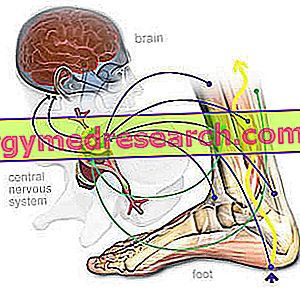By Dr. Davide Sganzerla
What is proprioceptive sensitivity?
The proprioceptive sensitivity is a very sophisticated mechanism, which aims to provide the Central Nervous System with information of the utmost precision, in real time, about:
1) parameters of the biomechanical movement (speed, force, direction, acceleration);
2) physiological parameters on the state and on the biological changes that occur in the muscles, tendons and joints as a result of the movement carried out.
Most proprioceptive information never reaches the level of consciousness, being in charge of controlling the processing of the motor project and its execution.
The control and execution of the motor project take place both in the transmission phase, in which the motor project elaborated in the brain is transmitted to the motor neurons, and in the execution phase, in which the motor neurons activate the locomotor apparatus that faithfully executes the orders received.
At this level, proprioception is very important, both for a control mechanism on the correct execution of the movement, and for a mechanism of possible correction in the event that unpredictable external phenomena disturb the strategically planned motor projects. It can therefore be said that proprioception is controlled by negative feedback circuits : the action performed by a system is compared with the programmed action and any difference (error) is reported to the system so that this activates the appropriate corrections.
The proprioceptive sensitivity, and in particular the proprioceptors, are also the basis of medullary reflexes: defense reactions designed to maintain the integrity of the body in the face of potentially harmful situations. In this task, the receptors activate some circuits, exclusively bone marrow, capable of causing reactive defense movements of the organism.

The conscious proprioceptive perception, which we all possess, is a construction elaborated by the cerebral cortex on the basis of information coming from peripheral proprioceptive receptors.
In this system, the complex integration of peripheral inputs from different perceptive channels is combined with information from memory and experience. Memory brings an informative baggage on past experiences, while experience is the instrument through which each of us colors the sensations coming from the external world, making them their own through the attribution of personal values.
The synthesis of the three types of information reported above gives rise to what is commonly called "body image", that is the awareness of the existence, position and movement of our body. Apart from the common sensory channels (sight, hearing, touch), each one forms this awareness through proprioceptive information.
Therefore, proprioceptivity describes the sensory inputs that originate, during centrally guided movements, from particular structures: the proprioceptors . Their main function is to provide feedback information on the organism's own movements, in other words to indicate, moment by moment, what movements the organism is making; precisely on the basis of this information the higher centers are able to correct or modify the movement in progress.
The proprioceptors
The proprioceptors are specialized sensory organs, which give information both on the positions taken by the body in quiet conditions (proprioception properly so called), and on the dynamic parameters of the movement (kinesthesia). The role of these messages can be very important, at the same time and at different levels, for many structures of the Central Nervous System.
There are three main systems in which the codes coming from the sensitive routes are processed.
A first, unconscious system is in charge of controlling and reacting to dangerous situations. This system guarantees immediate protection against any physical damage and is controlled mainly by the spinal cord .
A second system is in charge of controlling the execution of engine projects and automatisms. This system guarantees maximum precision and adherence between the motor project and movement in all movements, in order to obtain the greatest possible advantage. The system is predominantly controlled by the cerebellum and is also completely unconscious.
A third system uses the sensitive information coming from the peripheral receptors for conscious purposes. Through this system each of us forms and controls our own body image. This third system is mainly controlled by the cerebral cortex, which processes, integrating them in various ways, all the information coming from the periphery.
The proprioceptive sense organs can be divided into three main groups:
- the muscle receptors, which include the neuromuscular spindles, the Golgi tendon organs, the muscle-placed Pacini receptors, and the free muscle endings of the muscle, the perimysium and the epimysium;
- joint receptors;
- the cutaneous mechanoreceptors, which include Merkel's corpuscles, Meissner's corpuscles, Ruffini's corposculi and Pacini's corpuscles.
The spindles and organs of Golgi are receptors sensitive to the state of muscle lengthening, particularly useful in defining the parameters for the unconscious proprioceptive system (referring to the cerebellum) or for reflex responses (spinal cord). They play a role of primary importance both in proprioception and in the mechanisms of motor control. Moreover they seem to be more suitable to inform on the mechanical characteristics of the movement than on the state of rest of the locomotor apparatus. The sense of movement would therefore be the type of information preferably coded by them.
The articular and cutaneous receptors, although fundamental at the level of unconscious proprioception, play a more important role in static sensations, therefore in the sense of position (conscious proprioception). Studies have been carried out (Gandevia and Burke 1992) in which the afference of each of the cutaneous mechanoreceptors and of the articular receptors has been artificially stimulated and differences have been noted. The stimulation of the fibers coming from the Merkel corpuscles gives the sensation of skin pressure or indentation of the skin. The stimulation of the fibers coming from the Meisssner corpuscles gives the sensation of localized vibration, closely adhering to the duration and frequency of the stimulus. The stimulation of fibers coming from Ruffini's corpuscles gives the occasional sensation of joint movement. The stimulation by the fibers coming from the Pacini corpuscles gives the sensation of a diffused vibration. The sensation coming from the joint receptors gives the sensation of deep focused pressure, movement or joint stress.



